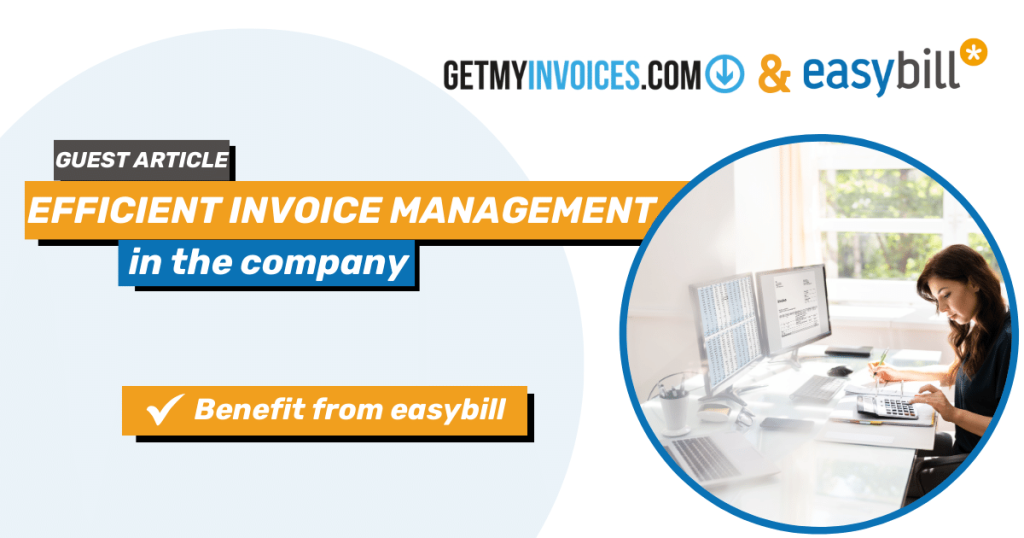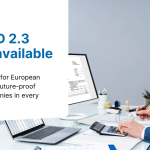
*Guest post: GetMyInvoices
Due to rising costs, companies are increasingly required to work efficiently. This also applies to preparatory accounting tasks, which can be automated by using a digital invoice management solution. You can find out how to reduce your costs in the blog article “How to save 80% of your accounting costs“.
Invoices arrive via a wide variety of channels: traditionally by post and electronically via various email addresses, from online portals or in the form of receipts. With this diversity, it used to be difficult and time-consuming to maintain an overview. However, intelligent, interface-friendly invoice management has changed accounting.
Table of contents
- Download invoices from online portals
- Process paper invoices digitally
- Collect invoices from e-mail inboxes
- Import invoices from third-party systems
- Automate invoice approval
- Handling of outgoing invoices
- Conclusion – The future is digital
Download invoices from online portals
Mobile phone providers, insurance companies, online stores and other companies make their invoices available for download in portals. Until now, the customer had to log into each portal, search for the relevant invoice and download it.
A solution for digital invoice management makes this process much simpler and faster. Users link the solution to the respective portals and enter their access data once.
The documents are then automatically retrieved from the platforms along with their history and uploaded to a central document archive. In addition, the solutions regularly check whether new invoices are available for download.
Process paper invoices digitally
Some companies still send their invoices on paper by post. Customers then have to enter the accounting-relevant data manually, which not only costs unnecessary time, but is also prone to errors. In addition, invoices must be stored for ten years in accordance with Section 147 of the German Fiscal Code (AO), which requires a corresponding amount of space. This space requirement is eliminated if incoming paper invoices are digitized.
Advanced invoice management solutions offer a scanning app for this purpose, with which paper invoices can simply be photographed and uploaded to the receipt archive. This is also practical on business trips, as fuel receipts, for example, can be captured on the go and not forgotten in the wallet.
Optical character recognition (OCR) is used to automatically capture booking-relevant data, eliminating the need for manual typing.
Collect invoices from e-mail inboxes
Electronic invoicing is becoming increasingly popular. No wonder, as suppliers save on printing and postage, which is also good for the environment. On the other hand, customers often have the problem that invoices end up in different e-mail inboxes, for example with the employees who placed an order. It can happen that the invoice is forgotten to be forwarded to the accounting department.
Sophisticated invoice management solutions can be connected to any number of email inboxes, where they can use machine learning and intelligent algorithms to recognize incoming invoices and upload them to the central document management system.
Import invoices from third-party systems
Many systems include invoice management, such as CRM solutions, store systems or industry-specific applications. The challenge for users is to make the invoices stored there available to the accounting department.
Invoice management solutions use interfaces to ensure that such documents are also available in the central document management system. To do this, they are connected once to the respective application so that they search for new invoices there at defined intervals and then import them into the central document management system.
Automate invoice approval
Individually customizable workflows accelerate the processing of incoming invoices. To do this, they map the path from receipt of the document to checking, approval and payment.
The user selects whether one or more people should be included in the workflow. In the next step, they define the relevant employees responsible, who are shown a list of the invoices to be checked, approved or paid in their dashboard. Invoices can be prioritized, for example to take advantage of discounts.
An integrated deputy function ensures that no invoice remains unprocessed if an employee is ill or on vacation.
Handling of outgoing invoices
As a rule, companies create their outgoing invoices in a third-party system, such as easybill. To ensure that these can also be found in the central document archive, modern invoice management solutions contain corresponding interfaces with which outgoing invoices can be automatically exported from the respective systems.
These are connected once to the invoice management solution, which searches for new invoices at set intervals and imports them into the central document management system.
Conclusion – The future is digital
A solution for digital invoice management, such as GetMyInvoices, relieves companies by automatically collecting all invoices from different sources. This means that the documents are available to the accounting department completely and promptly. An automated approval process also speeds up the invoice process considerably, allowing discounts to be taken advantage of and significantly reducing the workload of accounting staff.
As invoice management solutions automatically read out relevant information such as invoice date, net and gross amount and transfer it to the corresponding posting fields, typing errors during manual entry are a thing of the past. Of course, GetMyInvoices has an interface to easybill, so that you can easily import your outgoing invoices created there to GetMyInvoices and make them available to your accounting department in a timely manner.
Read also:
Master e-invoicing: A how-to guide for tax advisors and clients
How to create a professional invoice in 10 minutes with easybill



